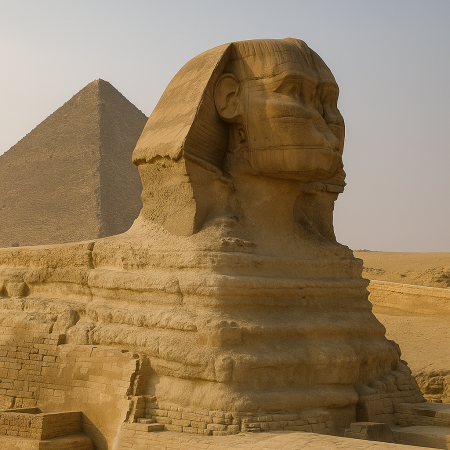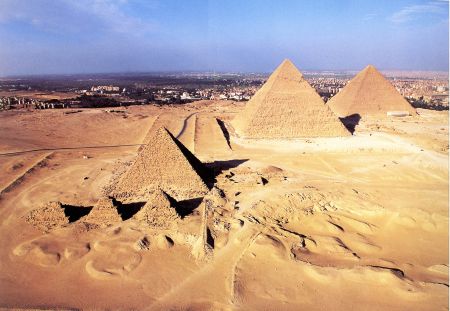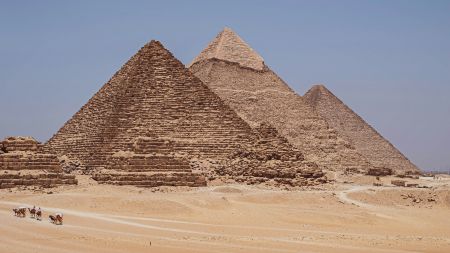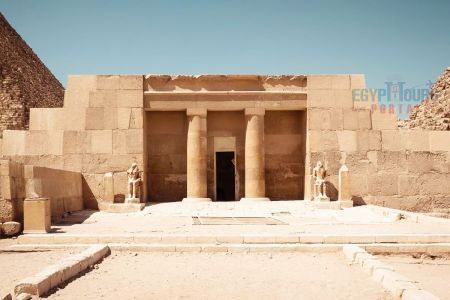The Grand Egyptian Museum
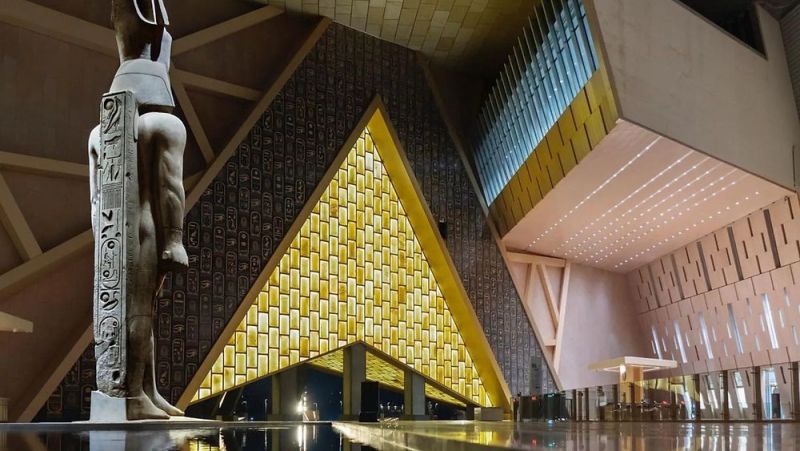
Rising in the shadow of the Great Pyramids of Giza, the Grand Egyptian Museum (GEM) is poised to become the most significant cultural and archaeological institution on Earth. Covering nearly 500,000 square meters, this ultra-modern structure blends ancient heritage with cutting-edge technology to house over 100,000 artifacts—many of which have never been publicly displayed before. Strategically positioned between Cairo and Giza, GEM is not just a museum; it’s a monumental gateway to Egypt’s glorious past, redefining how humanity interacts with one of the oldest civilizations.
Designed by Dublin-based architects Heneghan Peng, GEM is the largest museum in the world dedicated to a single civilization. It was built with the express purpose of preserving, displaying, and interpreting the vast treasures of ancient Egypt in a space worthy of their historical and cultural value. Once fully opened, it will offer visitors an unparalleled immersive journey through 7,000 years of Egyptian history—from the earliest dynasties to the Greco-Roman period.
Its architectural elegance—marked by a translucent alabaster façade, monumental staircases, panoramic glass walls overlooking the pyramids, and vast open galleries—turns every visit into an experience. But it’s what lies within that truly astounds: the complete collection of King Tutankhamun’s treasures, colossal statues, sarcophagi, royal mummies, and intricately preserved artifacts spanning all eras of Egypt’s ancient world.
The Vision and Construction of the Grand Egyptian Museum
A Legacy Project for the Modern Era
The idea for the Grand Egyptian Museum emerged in the early 2000s as Egypt’s existing museums became overcrowded and ill-equipped to handle the country’s immense heritage. The goal was simple: create a world-class, state-of-the-art complex that could conserve, display, and narrate Egypt’s epic history while accommodating the influx of tourists and researchers from around the globe.
Location and Symbolism
GEM’s placement just two kilometers from the Giza Pyramids is no coincidence. The museum aligns with the ancient causeway leading from the Valley Temple, echoing the spiritual journey from life to eternity. The structure's facade tilts in the direction of the pyramids, bridging the ancient world with modern interpretation.
Architectural Marvel and Design Features
-
Total Cost: Over $1 billion
-
Main Designer: Heneghan Peng Architects
-
Size: 480,000 square meters
-
Main Hall: Features a 12-meter-high statue of Ramses II
-
Iconic Elements: Golden triangle motif, grand staircase, panoramic glass curtain wall with pyramid views
The design incorporates symbolic geometric patterns and materials, such as locally sourced limestone and alabaster, echoing the materials used in ancient temples.
Book your unforgettable adventure with Luxury Egypt Tours
Museum Highlights and Exhibits
The Full Tutankhamun Collection – A Once-in-a-Lifetime Display
GEM will be the first and only museum to house the complete collection of King Tutankhamun’s treasures—over 5,000 items. These include the iconic golden death mask, gilded coffins, chariots, jewelry, ceremonial beds, and personal belongings. Many of these artifacts will be exhibited for the first time since their discovery in 1922.
Royal Mummies and the Hall of Kings
A specially designed gallery will house the royal mummies of the New Kingdom, including legendary pharaohs like Seti I, Ramses II, and possibly Nefertari. Each mummy will be presented with interactive displays detailing lineage, burial customs, and health analysis using the latest forensic technologies.
Colossal Statues and Architectural Pieces
GEM’s main atrium will greet visitors with monumental statues, including the massive seated figure of Ramses II and towering sculptures of gods and kings from across Egypt’s dynasties. These pieces were relocated from sites across the country and restored using advanced conservation methods.
The Grand Staircase – A Timeline in Stone
Climbing the Grand Staircase is like ascending through time itself. Along the ascent, visitors encounter more than 80 large artifacts chronologically arranged to tell the story of ancient Egypt’s evolution from early kingship to Greco-Roman influence.
Technological Integration and Visitor Experience
Immersive and Interactive Exhibits
Unlike traditional museums, GEM employs augmented reality (AR), 3D projections, virtual reconstructions, and multi-sensory rooms. Visitors can step inside a digital tomb, explore a pharaoh’s court, or examine artifacts up close using touchscreen displays.
Educational Facilities and Research Centers
GEM includes conference halls, children’s museums, libraries, and laboratories, making it a center for education and global archaeological collaboration. Scholars will have unprecedented access to artifacts and digital archives.
Conservation Laboratories – The Heart of Preservation
The museum’s Conservation Center is one of the largest in the world. Divided into several specialized labs, it focuses on the restoration of wood, metals, textiles, ceramics, papyrus, and human remains. Thousands of pieces have already been saved and studied here, including delicate items from the tomb of Tutankhamun.
Sustainability, Accessibility, and Global Impact
Eco-Friendly Design and Smart Systems
The GEM is designed with environmental sustainability in mind, incorporating energy-efficient lighting, solar power, and climate-controlled galleries that ensure the preservation of ancient materials without harming the planet.
Accessibility for All
Wide pathways, digital guides in multiple languages, wheelchair access, and educational aids ensure that GEM is inclusive and navigable for all visitors, regardless of age or ability.
Cultural Diplomacy and Tourism Revival
As Egypt’s flagship cultural project, GEM plays a crucial role in boosting tourism, fostering international goodwill, and enhancing the nation’s soft power. It is expected to attract over 5 million visitors annually, becoming a cultural hub for Africa and the Middle East.
Planning Your Visit to the Grand Egyptian Museum
How to Get There
Located near the Giza Plateau, the museum is easily accessible via Cairo’s ring road or through organized tours. Shuttles and private transfers from downtown Cairo hotels are widely available.
Ticketing and Opening Hours
GEM is scheduled to open in phases, with full public access expected by late 2025. Visitors are advised to check the official website for ticket prices, opening hours, and exhibition schedules.
Facilities and Services
On-site amenities include cafés, restaurants, souvenir shops, a conference center, open-air event spaces, and large parking areas. The surrounding gardens offer tranquil walking paths and pyramid views.
H2: Frequently Asked Questions about the Grand Egyptian Museum
Is the Grand Egyptian Museum open to the public yet?
GEM has opened partially for guided preview tours and VIP visits, with full public access expected by late 2025.
What makes GEM different from the Egyptian Museum in Tahrir?
GEM is significantly larger, more modern, and showcases complete collections—such as all of Tutankhamun’s artifacts—many of which were never displayed at the older museum.
Will the Royal Mummies be moved from the NMEC to GEM?
As of now, the Royal Mummies are housed at the National Museum of Egyptian Civilization (NMEC), but GEM will feature some additional royal remains and interactive displays.
How long does a typical visit to GEM take?
A standard visit may last 3–4 hours, but history enthusiasts can easily spend an entire day exploring the galleries, exhibitions, and amenities.
Are there guided tours available?
Yes, both private and group guided tours are available in multiple languages, offering deep insights into Egypt’s vast history.
Conclusion: The Grand Egyptian Museum – Where Ancient Egypt Meets the Future
The Grand Egyptian Museum stands as a triumph of vision, architecture, and cultural preservation. By blending ancient majesty with modern innovation, GEM redefines what a museum can be. Whether you’re seeing Tutankhamun’s treasures in their full glory, walking beneath the gaze of Ramses II, or experiencing an interactive virtual tomb, the GEM offers a transformative journey through history. It's not just Egypt’s greatest museum—it’s the world's most complete expression of one of the most iconic civilizations in human history.


